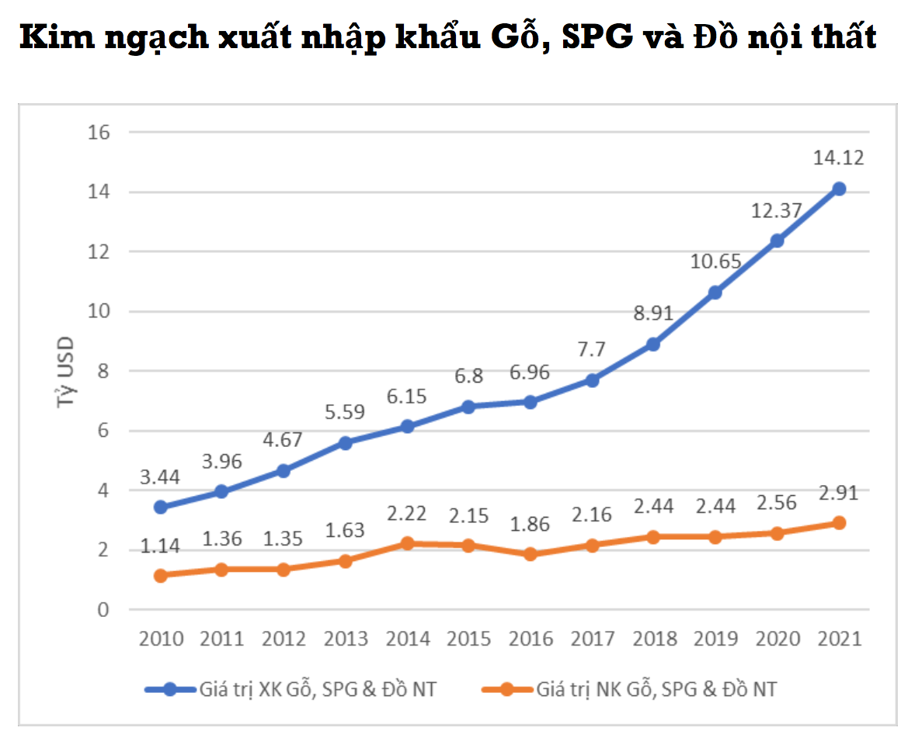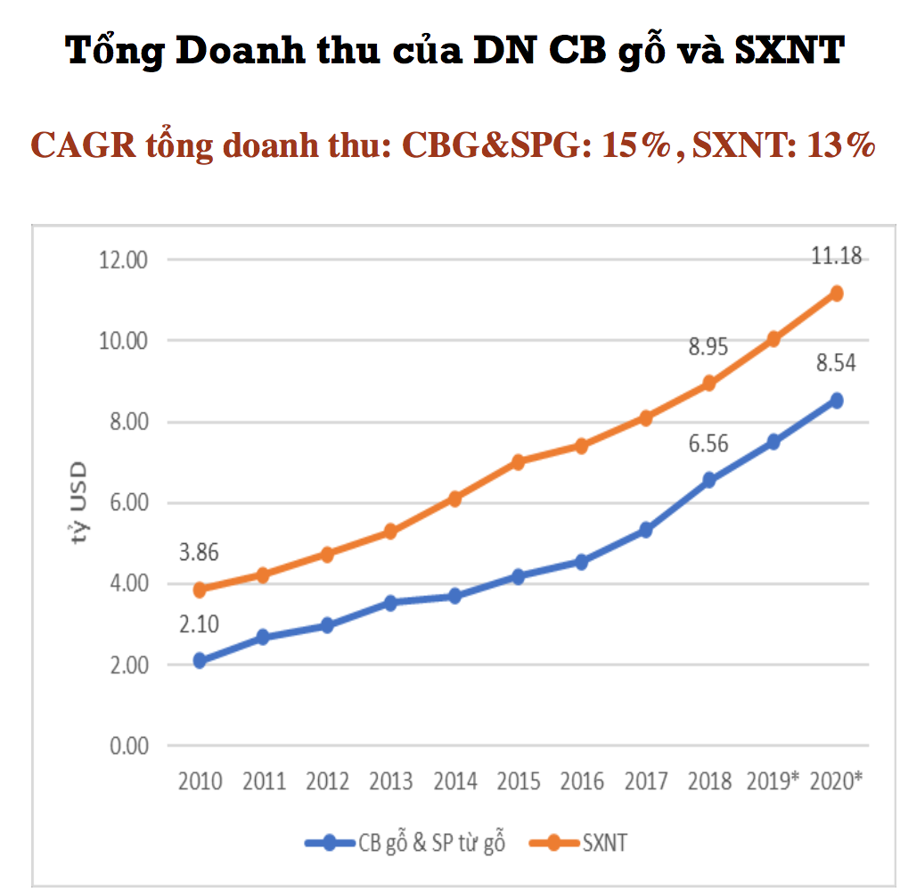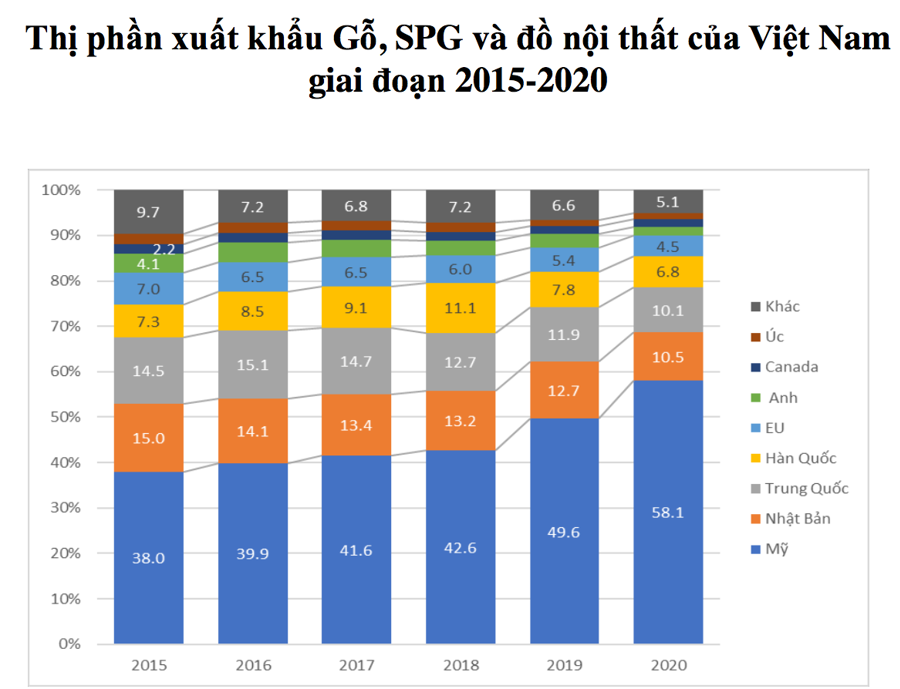Source: vneconomy.vn
The demand for wooden furniture at home and abroad is increasing due to the aesthetics of home space and places such as restaurants, hotels, offices, entertainment, commercial centers… continuously increasing usage. Use wooden furniture due to the luxury and durability of the product.
VIETNAM WOOD EXPORTS THE 7th in the world, FDI accounts for nearly 40%
Table of Contents
According to Ms. Do Thi Thu Huong, an expert from the Office of the Private Economic Development Research Board (Board IV), Vietnam’s wood industry has had the most dynamic growth rate in the world over the past 10 years and has risen to the top position. 7th in the world in the production of wood products and furniture. Wood export is one of eight items with export turnover of over 10 billion USD in 2021.

Over the past 10 years, (2010-2021), the export turnover of wood, wood products and furniture has increased more than 4 times, from 3.44 billion USD in 2010 to 14.12 billion USD in 2021. .
Wood export surplus ranks third, providing more than half a million jobs. However, FDI enterprises create 43% of jobs and 36% of revenue for the industry while accounting for only 5% of the total number of wood enterprises, most of which are Vietnamese private enterprises accounting for more than 92%; large enterprises and cooperatives accounted for 2.9%.

Total revenue of furniture manufacturing enterprises also increased rapidly from 3.86 billion USD in 2010 to 11.18 billion USD in 2020, nearly 3 times after 10 years. The revenue of wood processing and wood products increased from 2.1 billion USD in 2010 to 8.54 billion USD in 2020, 4 times after 10 years.
Regarding the wood export market, the US is the country that accounts for more than half of the export volume of Vietnamese wood enterprises. The export market share to the US continuously increased sharply from 38% in 2015 to 58.1% in 2020. Other major export markets are Australia, China, Japan, Korea, and the EU.

It is forecasted that the global furniture market still has great potential with a compound growth rate of 3.75%. In 2020, Vietnam only accounts for 2.58% of the total global furniture market size, reaching 509.8 billion USD, the potential for growth is still great. By 2027, it will reach about 650 billion USD and the growth will shift to the Asia-Pacific region.
According to the Government’s plan for the development of the wood industry, by 2025, wood exports will reach 20 billion USD, domestic consumption will reach 5 billion USD; By 2030, it will reach 25 billion USD, domestic consumption will be 6 billion USD.
More than 80% of wood processing and preservation establishments have reached the level and capacity of advanced production technology; 100% wood, wood products, wood products from legal wood materials, certified wood for sustainable forest management.
The goal of Vietnam’s wood industry is to achieve the export target of 20 billion USD, in which, Vietnamese enterprises must account for 60-70% of export turnover, 30% of export enterprises can create value-added products. high, 20% of export value is ODM…
URGENTLY PLANNING MATERIAL FORESTS
According to Ms. Huong, with the market shift to the Asia-Pacific region, the main competitor of Vietnamese wood products is China when this country leads in furniture export, accounting for 38% of the market. parts of the world (2015). Malaysia is competing closely with Vietnam in the US and Japanese markets…
Meanwhile, the Vietnamese wood industry is facing many challenges, such as: there is no synchronous policy to create momentum for the industry. Not paying attention to synchronous investment in raw materials and supporting industries.
The wood and wood processing industries are lacking in concentrated raw materials. Because at present, there are 3.19 million ha of household plantation forest, 1.45 million ha of household production forest is mainly small timber, the rest of the household is natural forest.
Forests planted by forestry companies currently have 112 active forestry companies holding a total forest land area of over 1.47 million hectares.
Meanwhile, the afforestation area certified for sustainable management accounts for 8.4% of the total planted forest area of the country, about 307,000 ha.
Regarding the source of wood materials for wood processing, in 2020, the total demand for raw wood is 38.5 million m3 of round logs. In which, the source of wood materials harvested domestically is estimated at 30 million m3, accounting for 75% (exploitation from planted forests is 20.5 million m3; exploitation from scattered trees and rubber wood is about 9.5 million m3). ).
The source of imported wood materials is about 8.5 million m3, accounting for 25% of the total wood volume of the processing industry.
In addition, the cost of imported wood and the cost of exported goods is a problem that increases costs and reduces the competitiveness of Vietnamese enterprises.
The supply of legal timber from abroad has not been controlled in practice, so there is a potential risk of legality.
Therefore, the possibility of commercial fraud of enterprises by using goods imported from China, changing origin from Vietnam is a huge potential risk for the industry.
Emphasizing the important issue of the wood industry is the raw material area, Mr. Do Xuan Lap, Chairman of the Vietnam Timber and Forest Products Association (VIFOREST), said that the industry is considering implementing the forestry chain: afforestation – production. intermediate materials – deep processing.
However, the development of domestic raw materials is disappointing when the afforestation of the country lacks from policies to planting techniques and scale…
“We are losing balance in terms of afforestation and tree varieties, leading to very low efficiency of the forestry chain,” said Mr. Lap.
According to Mr. Thang Van Thong, Hao Hung Group, the development of wood raw materials has a lot of potential but is entangled with policies. Currently, there are 03 types of land: natural forest land (but no biomass reserves); barren land; The land located in forestry companies in the provinces is still very large.
VIFOREST can propose to the Government to put all of the above land into production and afforestation, so that after 10 years, Vietnam will no longer worry about the raw material area.
“Enterprises have to import wood for export processing. The problem is that the price is not stable, sometimes it doesn’t? So why does Vietnam have the Truong Son mountain range with fertile soil for afforestation but we can’t do it?”
Mr. Thang Van Thong, Hao Hung Group
Regarding plant varieties, currently forest land in Vietnam accounts for 43-47% of the total forestry land area. Forest land is allocated to people for spontaneous cultivation, so it does not create a large raw material area.
In fact, wood businesses have also linked with households to plant forests, but the area is very small, making the material forest only 1000ha at most. Survey data of 311 private enterprises in Vietnam: only 10.5% of enterprises have signed long-term contracts (from 36 months or more) with domestic raw material suppliers; More than 7% of enterprises have signed long-term contracts with foreign raw material suppliers.
According to Mr. Tran Dinh Thien, former director of the Vietnam Institute of Economics, the role of the wood industry is important, but it is one of the industries that receive little investment and attention from the State. The growth of the wood industry, both domestically and internationally, does not depend on public investment.
The question is the future, what solution for the wood industry with the Government’s implementation of the COP26 commitment (United Nations Framework Convention on Climate Change)? (The wood industry belongs to 06 groups of industries that carry out risk responsibility for COP26, by 2030 the use of natural wood must stop). It is necessary to propose to the Government to plan land for planting production forests in amending and supplementing the 2013 Land Law.
Board IV recommends the Government to issue a policy to allow forestry companies with low use efficiency to contribute land to cooperate so that wood industry enterprises can access this land fund to develop large timber resources.
At the same time, with strong mechanisms and policies to promote the formation of linkages between households and processing companies, the Government reviews bare land and bare hills to allow companies to participate in afforestation on the land area. this; There is a specific mechanism to promote investment in chain link from afforestation to deep processing; License to build an industrial park specialized in wood processing in 2022.
The Government will study the establishment of a fund for medium and long-term loans to enterprises with preferential interest rates; Promulgating policies to limit and completely eliminate imported timber from areas with legal risks…
